
List of palettes
Encyclopedia
This article is a list of the color palette
s for notable computer graphics
, terminals
and video game console
hardware.
Only a sample and the palette's name are given here. More specific articles are linked from the name of each palette, for the test charts, samples, simulated images, and further technical details (including references).
In the past, manufacturers have developed many different display systems in a competitive, non-collaborative basis (with a few exceptions, as the VESA
consortium), creating many proprietary, non-standard different instances of display hardware
. Often, as with early personal
and home computer
s, a given machine employed its unique display subsystem, with its also unique color palette. Also, software
developers had made use of the color abilities of distinct display systems in many different ways. The result is that there is no single common standard nomenclature or classification taxonomy which can encompass every computer color palette.
In order to organize the material, color palettes have been grouped following arbitrary but rational criteria. First, generic monochrome and full RGB repertories common to various computer display systems. Second, usual color repertories used for display systems that employ indexed color
techniques. And finally, specific manufacturers' color palettes implemented in many representative early personal computer
s and videogame console
s of various brands.
The list for personal computer palettes is split into two categories: 8-bit
and 16-bit
machines. This is not intended as a true strict categorization of such machines, because mixed architectures also exist (16-bit processor
s with an 8-bit data bus or 32-bit processors with a 16-bit data bus, among others). The distinction is based more on broad 8-bit and 16-bit computer ages or generations (around 1975–1985 and 1985–1995, respectively) and their associated state of the art
in color display capabilities.
Here is the common color test chart and sample image used to render every palette in this series of articles:
See further details in the summary paragraph of the corresponding article.
These are generic complete repertories of colors to produce black and white and RGB color pictures by the display hardware, not necessarily the total number of such colors that can be simultaneously displayed in a given text or graphic mode of any machine. RGB is the most common method to produce colors for displays; so these complete RGB color repertories have every possible combination of R-G-B triplets within any given maximum number of levels per component.
For specific hardware and different methods to produce colors than RGB, see the List of computer hardware palettes and the List of videogame consoles sections.
For various software arrangements and sorts of colors, including other possible full RGB arrangements within 8-bit depth
displays, see the List of software palettes section.
can display up to 16 or 256 colors simultaneously. Many personal computer
s in the later 1980s and early 1990s displayed at most 256 different colors, freely selected by software (either by the user or by a program) from their wider hardware's color palette.
Usual selections of colors in limited subsets (generally 16 or 256) of the full palette includes some RGB level arrangements commomly used with the 8 bpp palettes as master palettes or universal palettes (i.e., palettes for multipurpose uses).
These are some representative software palettes, but any selection can be made in such types of systems.
s and terminals
that offered color displays, some color palettes were chosen algorithmically to provide the most diverse set of colors for a given palette size, and others were chosen to assure the availability of certain colors. In many early home computers, especially when the palette choices were determined at the hardware level by resistor
combinations, the palette was determined by the manufacturer.
Many of early models output composite video
YPbPr
colors. When seen on TV devices, the perception of the colors may not correspond with the value levels for the YPbPr values employed (most noticeable with NTSC TV color system).
For current RGB display systems for PC
's (Super VGA, etc.), see the 16-bit RGB and 24-bit RGB for HighColor (thousands) and TrueColor (millions of colors) modes.
For video game console
s, see the List of videogame consoles section.
For every model, their main different graphical color modes are listed based exclusively in the way they handle colors on screen, not all their different screen modes.
The list is ordered roughly historically by video hardware, not grouped by branch. They are listed according to the original model of every system, which implies that enhanced versions, clones and compatibles also support the original palette.
Palette (computing)
In computer graphics, a palette is either a given, finite set of colors for the management of digital images , or a small on-screen graphical element for choosing from a limited set of choices, not necessarily colors .Depending on the context In computer graphics, a palette is either a given,...
s for notable computer graphics
Computer graphics
Computer graphics are graphics created using computers and, more generally, the representation and manipulation of image data by a computer with help from specialized software and hardware....
, terminals
Computer terminal
A computer terminal is an electronic or electromechanical hardware device that is used for entering data into, and displaying data from, a computer or a computing system...
and video game console
Video game console
A video game console is an interactive entertainment computer or customized computer system that produces a video display signal which can be used with a display device to display a video game...
hardware.
Only a sample and the palette's name are given here. More specific articles are linked from the name of each palette, for the test charts, samples, simulated images, and further technical details (including references).
In the past, manufacturers have developed many different display systems in a competitive, non-collaborative basis (with a few exceptions, as the VESA
VESA
VESA is an international standards body for computer graphics founded in 1989 by NEC Home Electronics and eight other video display adapter manufacturers.VESA's initial goal was to produce a standard for 800×600 SVGA resolution video displays...
consortium), creating many proprietary, non-standard different instances of display hardware
Computer hardware
Personal computer hardware are component devices which are typically installed into or peripheral to a computer case to create a personal computer upon which system software is installed including a firmware interface such as a BIOS and an operating system which supports application software that...
. Often, as with early personal
Personal computer
A personal computer is any general-purpose computer whose size, capabilities, and original sales price make it useful for individuals, and which is intended to be operated directly by an end-user with no intervening computer operator...
and home computer
Home computer
Home computers were a class of microcomputers entering the market in 1977, and becoming increasingly common during the 1980s. They were marketed to consumers as affordable and accessible computers that, for the first time, were intended for the use of a single nontechnical user...
s, a given machine employed its unique display subsystem, with its also unique color palette. Also, software
Computer software
Computer software, or just software, is a collection of computer programs and related data that provide the instructions for telling a computer what to do and how to do it....
developers had made use of the color abilities of distinct display systems in many different ways. The result is that there is no single common standard nomenclature or classification taxonomy which can encompass every computer color palette.
In order to organize the material, color palettes have been grouped following arbitrary but rational criteria. First, generic monochrome and full RGB repertories common to various computer display systems. Second, usual color repertories used for display systems that employ indexed color
Indexed color
In computing, indexed color is a technique to manage digital images' colors in a limited fashion, in order to save computer memory and file storage, while speeding up display refresh and file transfers...
techniques. And finally, specific manufacturers' color palettes implemented in many representative early personal computer
Personal computer
A personal computer is any general-purpose computer whose size, capabilities, and original sales price make it useful for individuals, and which is intended to be operated directly by an end-user with no intervening computer operator...
s and videogame console
Video game console
A video game console is an interactive entertainment computer or customized computer system that produces a video display signal which can be used with a display device to display a video game...
s of various brands.
The list for personal computer palettes is split into two categories: 8-bit
8-bit
The first widely adopted 8-bit microprocessor was the Intel 8080, being used in many hobbyist computers of the late 1970s and early 1980s, often running the CP/M operating system. The Zilog Z80 and the Motorola 6800 were also used in similar computers...
and 16-bit
16-bit
-16-bit architecture:The HP BPC, introduced in 1975, was the world's first 16-bit microprocessor. Prominent 16-bit processors include the PDP-11, Intel 8086, Intel 80286 and the WDC 65C816. The Intel 8088 was program-compatible with the Intel 8086, and was 16-bit in that its registers were 16...
machines. This is not intended as a true strict categorization of such machines, because mixed architectures also exist (16-bit processor
Central processing unit
The central processing unit is the portion of a computer system that carries out the instructions of a computer program, to perform the basic arithmetical, logical, and input/output operations of the system. The CPU plays a role somewhat analogous to the brain in the computer. The term has been in...
s with an 8-bit data bus or 32-bit processors with a 16-bit data bus, among others). The distinction is based more on broad 8-bit and 16-bit computer ages or generations (around 1975–1985 and 1985–1995, respectively) and their associated state of the art
State of the art
The state of the art is the highest level of development, as of a device, technique, or scientific field, achieved at a particular time. It also refers to the level of development reached at any particular time as a result of the latest methodologies employed.- Origin :The earliest use of the term...
in color display capabilities.
Here is the common color test chart and sample image used to render every palette in this series of articles:
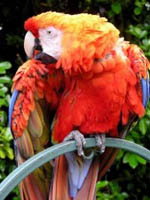 |
 |
See further details in the summary paragraph of the corresponding article.
List of monochrome and RGB palettes
For the purpose of this article, the term monochrome palette means a set of intensities for a monochrome display, and the term RGB palette is defined as the complete set of combinations a given RGB display can offer by mixing all the possible intensities of the red, green, and blue primaries available in its hardware.These are generic complete repertories of colors to produce black and white and RGB color pictures by the display hardware, not necessarily the total number of such colors that can be simultaneously displayed in a given text or graphic mode of any machine. RGB is the most common method to produce colors for displays; so these complete RGB color repertories have every possible combination of R-G-B triplets within any given maximum number of levels per component.
For specific hardware and different methods to produce colors than RGB, see the List of computer hardware palettes and the List of videogame consoles sections.
For various software arrangements and sorts of colors, including other possible full RGB arrangements within 8-bit depth
Color depth
In computer graphics, color depth or bit depth is the number of bits used to represent the color of a single pixel in a bitmapped image or video frame buffer. This concept is also known as bits per pixel , particularly when specified along with the number of bits used...
displays, see the List of software palettes section.
Monochrome palettes
- These palettes only have some shades of gray.
 |
Monochrome (1-bit) black and white |
Monochrome (1-bit) black and white, with Floyd-Steinberg dithering Floyd-Steinberg dithering Floyd–Steinberg dithering is an image dithering algorithm first published in 1976 by Robert W. Floyd and Louis Steinberg. It is commonly used by image manipulation software, for example when an image is converted into GIF format that is restricted to a maximum of 256 colors.The algorithm achieves... |
|
 |
2-bit Grayscale 22 = 4 levels of gray |
4 levels of gray, with Floyd-Steinberg dithering | |
 |
4-bit Grayscale 24 = 16 levels of gray |
16 levels of gray, with Floyd-Steinberg dithering | |
 |
8-bit Grayscale 28 = 256 levels of gray |
||
Regular RGB palettes
- These full RGB palettes employ the same number of bitBitA bit is the basic unit of information in computing and telecommunications; it is the amount of information stored by a digital device or other physical system that exists in one of two possible distinct states...
s to store the relative intensity for the red, green and blue components of every image's pixelPixelIn digital imaging, a pixel, or pel, is a single point in a raster image, or the smallest addressable screen element in a display device; it is the smallest unit of picture that can be represented or controlled....
color. Thus, they have the same number of levels per channel and the total number of possible colors is always the cube of a power of two.
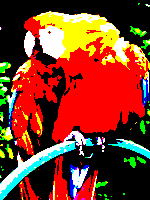 |
3-bit RGB 23 = 8 colors |
3-bit RGB, with Floyd-Steinberg dithering Floyd-Steinberg dithering Floyd–Steinberg dithering is an image dithering algorithm first published in 1976 by Robert W. Floyd and Louis Steinberg. It is commonly used by image manipulation software, for example when an image is converted into GIF format that is restricted to a maximum of 256 colors.The algorithm achieves... |
|
 |
6-bit RGB 43 = 64 colors |
||
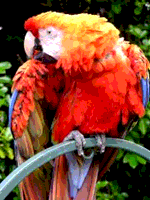 |
9-bit RGB 83 = 512 colors |
||
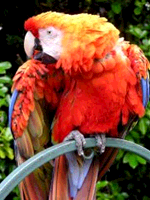 |
12-bit RGB 163 = 4096 colors |
||
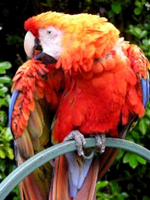 |
15-bit RGB 323 = 32,768 colors (HighColor) |
||
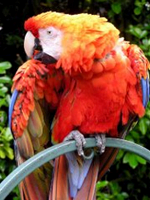 |
18-bit RGB 643 = 262,144 colors |
||
 |
24-bit RGB 2563 = 16,777,216 colors (TrueColor) |
||
Non-regular RGB palettes
- These are also RGB palettes, in the sense defined above (except for the 4-bit RGBI, which has an intensity bit that affects all channels at once), but either they do not have the same number of levels for each primary channel, or the numbers are not powers of two, so are not represented as separate bit fields. All of these have been used in popular personal computerPersonal computerA personal computer is any general-purpose computer whose size, capabilities, and original sales price make it useful for individuals, and which is intended to be operated directly by an end-user with no intervening computer operator...
s.
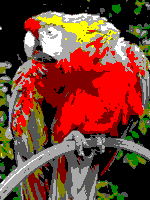 |
4-bit RGBI 23×2 = 16 colors |
 |
3-level RGB 33 = 27 colors |
 |
3-3-2 bit RGB 8×8×4 = 256 colors |
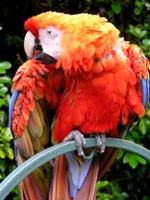 |
16-bit RGB 32×64×32 = 65,536 colors (HighColor) |
List of software palettes
Systems that use a 4-bit or 8-bit pixel depthColor depth
In computer graphics, color depth or bit depth is the number of bits used to represent the color of a single pixel in a bitmapped image or video frame buffer. This concept is also known as bits per pixel , particularly when specified along with the number of bits used...
can display up to 16 or 256 colors simultaneously. Many personal computer
Personal computer
A personal computer is any general-purpose computer whose size, capabilities, and original sales price make it useful for individuals, and which is intended to be operated directly by an end-user with no intervening computer operator...
s in the later 1980s and early 1990s displayed at most 256 different colors, freely selected by software (either by the user or by a program) from their wider hardware's color palette.
Usual selections of colors in limited subsets (generally 16 or 256) of the full palette includes some RGB level arrangements commomly used with the 8 bpp palettes as master palettes or universal palettes (i.e., palettes for multipurpose uses).
These are some representative software palettes, but any selection can be made in such types of systems.
System specifics
- These are selections of colors officially employed as system palettes in some popular operating systemOperating systemAn operating system is a set of programs that manage computer hardware resources and provide common services for application software. The operating system is the most important type of system software in a computer system...
s for personal computerPersonal computerA personal computer is any general-purpose computer whose size, capabilities, and original sales price make it useful for individuals, and which is intended to be operated directly by an end-user with no intervening computer operator...
s that features 8-bit displays.
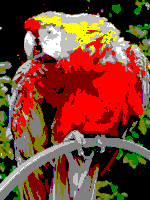 |
Microsoft Windows default 16-color palette 16 colors |
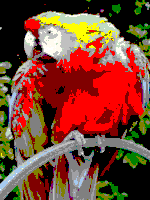 |
Microsoft Windows default 20-color palette 20 colors |
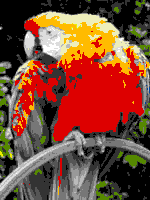 |
RISC OS default 16-color palette 16 colors |
RGB arrangements
- These are selections of colors based on evenly ordered RGB levels, mainly used as master palettes to display any kind of image within the limitations of the 8-bit pixel depth.
 |
6 level RGB 63 = 216 colors |
 |
6-7-6 levels RGB 6×7×6 = 252 colors |
 |
6-8-5 levels RGB 6×8×5 = 240 colors |
 |
8-8-4 levels RGB 8×8×4 = 256 colors |
Other common uses of software palettes
 |
Grayscale palettes up to 256 levels of gray |
_palette_sample_image.png) |
Color gradient palettes up to 256 levels of any arbitrary hue |
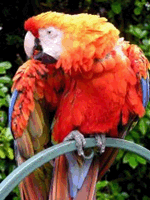 |
Adaptive palettes up to 256 picked colors |
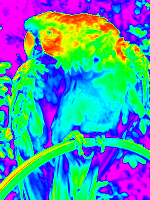 |
False color palettes up to 256 continuous-tone colors |
List of computer hardware palettes
In early personal computerPersonal computer
A personal computer is any general-purpose computer whose size, capabilities, and original sales price make it useful for individuals, and which is intended to be operated directly by an end-user with no intervening computer operator...
s and terminals
Computer terminal
A computer terminal is an electronic or electromechanical hardware device that is used for entering data into, and displaying data from, a computer or a computing system...
that offered color displays, some color palettes were chosen algorithmically to provide the most diverse set of colors for a given palette size, and others were chosen to assure the availability of certain colors. In many early home computers, especially when the palette choices were determined at the hardware level by resistor
Resistor
A linear resistor is a linear, passive two-terminal electrical component that implements electrical resistance as a circuit element.The current through a resistor is in direct proportion to the voltage across the resistor's terminals. Thus, the ratio of the voltage applied across a resistor's...
combinations, the palette was determined by the manufacturer.
Many of early models output composite video
Composite video
Composite video is the format of an analog television signal before it is combined with a sound signal and modulated onto an RF carrier. In contrast to component video it contains all required video information, including colors in a single line-level signal...
YPbPr
YPbPr
' is a color space used in video electronics, in particular in reference to component video cables. is the analog version of the YCBCR color space; the two are numerically equivalent, but YPBPR is designed for use in analog systems whereas YCBCR is intended for digital video. cables are also...
colors. When seen on TV devices, the perception of the colors may not correspond with the value levels for the YPbPr values employed (most noticeable with NTSC TV color system).
For current RGB display systems for PC
Personal computer
A personal computer is any general-purpose computer whose size, capabilities, and original sales price make it useful for individuals, and which is intended to be operated directly by an end-user with no intervening computer operator...
's (Super VGA, etc.), see the 16-bit RGB and 24-bit RGB for HighColor (thousands) and TrueColor (millions of colors) modes.
For video game console
Video game console
A video game console is an interactive entertainment computer or customized computer system that produces a video display signal which can be used with a display device to display a video game...
s, see the List of videogame consoles section.
For every model, their main different graphical color modes are listed based exclusively in the way they handle colors on screen, not all their different screen modes.
The list is ordered roughly historically by video hardware, not grouped by branch. They are listed according to the original model of every system, which implies that enhanced versions, clones and compatibles also support the original palette.
Terminals and 8-bit machines
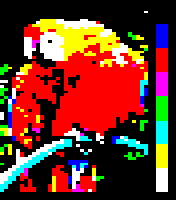 |
Teletext (1976) Graphic block characters, 8-color |
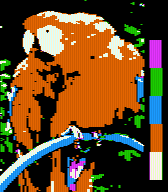 |
Apple II (1977) Low 16- and high resolution 4-color graphic modes |
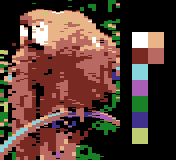 |
Commodore VIC-20 (1981) 200 definable characters of 8×16 bits each, 8- or 10-color modes |
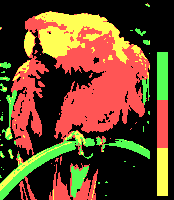 |
CGA for IBM-PC (1981) 16-colors text mode, 4-color and monochrome graphic modes |
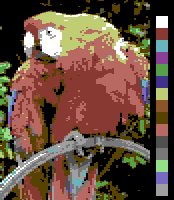 |
Commodore 64 (1982) Multicolor and High resolution 16-color graphic modes |
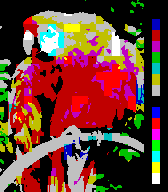 |
ZX Spectrum (1982) 15-colors by attributes |
| Mattel Aquarius (1983) |
|
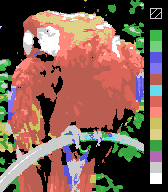 |
MSX systems (1983) "Screen 2" and "Screen 3" 15-color graphic modes |
| Thomson MO5 (1984) |
|
 |
Commodore Plus/4 (1984) Multicolor and High resolution 16-color graphic modes |
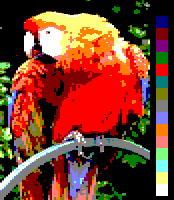 |
Amstrad CPC (1984) Low 16-, medium 4- and high resolution 2-color graphic modes |
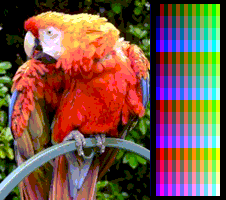 |
MSX2 systems (1985) "Screen 5" 16- and "Screen 8" 256-color graphic modes |
 |
MSX2+ systems (1988) "Screen 10&11" 12,499- YJK+YAE and "Screen 12" 19,268-color YJK graphic modes |
16-bit machines
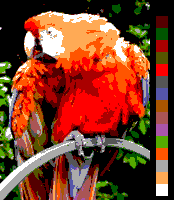 |
EGA for IBM-AT (1984) Medium and high resolution 16-color graphic modes |
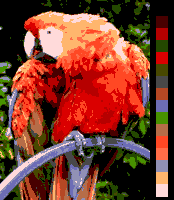 |
Atari ST (1985) Low 16-, medium 4-color and high resolution monochrome modes |
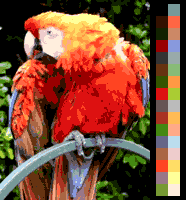 |
Commodore Amiga OCS (1985) 2-, 4-, 8-, 16- and 32-color standard graphic modes, EHB 64- and HAM 4096-color enhanced modes |
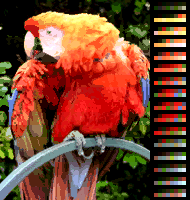 |
Apple IIgs (1986) Super High Res 4-, 8-, 16- and 256-color graphic modes |
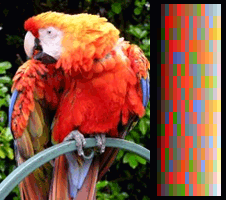 |
MCGA and VGA for IBM-AT (1987) Medium 256- and high resolution 16-color graphic modes |
List of videogame console palettes
Color palettes of some of the most popular videogame consoles. The criteria are the same as those of the List of computer hardware palettes section.  |
Atari 2600 4 out of 128 colors on every scanline |
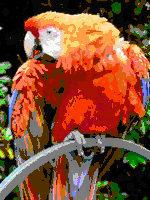 |
NES 25 out of 54 colors |
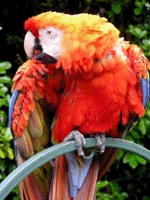 |
SuperNES 256 out of 32,768 colors |
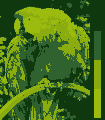 |
Nintendo Gameboy 4 shades of green |
 |
Nintendo Gameboy Color Type 1 cartridges tricky 10-color (4+2×3) startup palettes (not shown here) and Type 3 32-color cartridges (actually 32+8×3) |
 |
Nintendo Gameboy Advance/SP/Micro Type 3 32-color and Type 4 32,768-color cartridges |
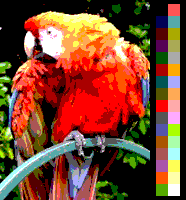 |
SEGA Master System 32-color out of 64 |
 |
SEGA Game Gear 32-color out of 4,096 |
| (No example available) | SEGA Mega Drive/Genesis 61-color out of 512 |
| (No example available) | NEC PC-Engine/TurboGrafx 16 482-color out of 512 |
See also
- Color depthColor depthIn computer graphics, color depth or bit depth is the number of bits used to represent the color of a single pixel in a bitmapped image or video frame buffer. This concept is also known as bits per pixel , particularly when specified along with the number of bits used...
- Color Lookup TableCLUTA colour look-up table is a mechanism used to transform a range of input colours into another range of colours. It can be a hardware device built into an imaging system or a software function built into an image processing application...
- Computer displayComputer displayA monitor or display is an electronic visual display for computers. The monitor comprises the display device, circuitry, and an enclosure...
- Indexed colorIndexed colorIn computing, indexed color is a technique to manage digital images' colors in a limited fashion, in order to save computer memory and file storage, while speeding up display refresh and file transfers...
- List of colors (compact)
- List of home computers by video hardware
- Palette (computing)Palette (computing)In computer graphics, a palette is either a given, finite set of colors for the management of digital images , or a small on-screen graphical element for choosing from a limited set of choices, not necessarily colors .Depending on the context In computer graphics, a palette is either a given,...
- Web colorsWeb colorsWeb colors are colors used in designing web pages, and the methods for describing and specifying those colors. Hexadecimal color codes begin with a hash ....
- X11 color namesX11 color namesIn computing, on the X Window System, X11 color names are represented in a simple text file, which maps certain strings to RGB color values. It is shipped with every X11 installation, hence the name, and is usually located in <X11root>/lib/X11/rgb.txt.It is not known who originally compiled...

